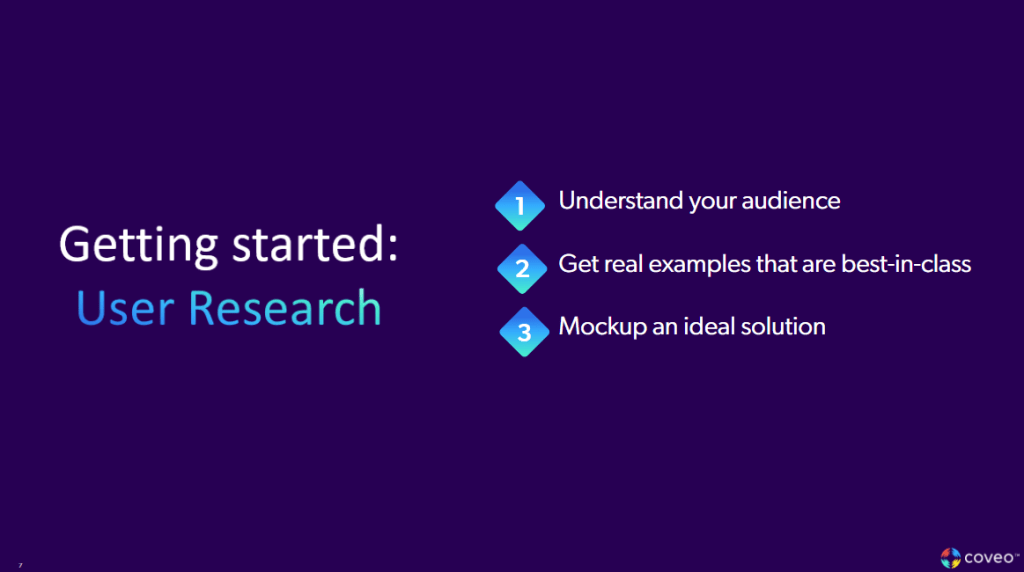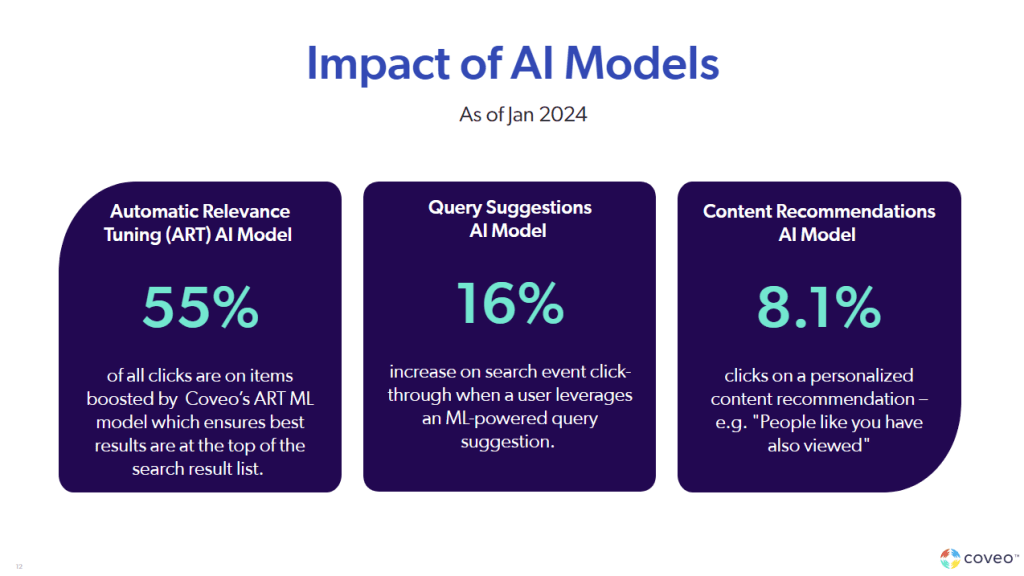Founded in 1984, Cisco Systems, Inc. is an American multinational digital communications corporation ranked 82nd on the Fortune 100 list. With over $51 billion in revenue and nearly 83,300 employees, it is one of the largest technology companies in the world, offering an industry-leading portfolio of high-technology services and products such as networking hardware and software, telecommunications equipment, cloud management, and more, with the goal of “securely connecting industries and communities.”
Cisco’s SalesConnect is an application used by around 350,000 Cisco internal and partner distributors organized into 70+ unique distinct groups which allows its sellers and partners to have the latest information about the company’s diverse set of products right at their fingertips, helping them to be better prepared in customer conversations.
Gira Raff, Senior Manager for Revenue and Automation at Cisco, recently joined Coveo’s Sr. Director of Product Marketing Juanita Olguin to talk about their journey. Raff said: “Users go to SalesConnect to find content and share it with their customers or partners. The ultimate goal for end users on SalesConnect is to be able to successfully position the extensive Cisco product and services portfolio and be able to land a deal as a result of that.”
The Impetus for Change
As a small business team of only 13 people working with a much larger IT team, Cisco felt that they needed to be more in control of the user experience and their ability to impact it through activities such as performance tuning.
While SalesConnect was doing what it was designed to do, it wasn’t meeting the expectations of its end users.
“Our search experience wasn’t great,” shared Raff. “Users were complaining about the UI, and it was hard for them to find what they were looking for. We knew we needed to do something dramatic to elevate their experience so we thought AI would be the right way to do that.”
There was also the cost factor. SalesConnect is a custom application, created through collaboration with multiple vendors to support Cisco’s innovation. This made it very difficult to scale.
While it was clear that SalesConnect needed new features, Cisco didn’t have the deep industry knowledge needed to develop them and wanted to work with someone who could guide them on the best practices and industry benchmarks.
The Importance of User Research
Before starting the re-platforming of SalesConnect, Cisco took a step back to better understand the issues around their user base, and determine the best way to address them.

Raff shares that her professional motto is “Leave your ego at the door.” She elaborates: “When you’re thinking about user experience it’s important to set aside your biases, your possessiveness or defensiveness around what you own, and instead lean into being able to understand other people’s experience of your product because this is the only way to get the necessary insight that would allow you to elevate their experience further.”
Their user research was a three-step process.
- Surveys and Interviews. The first step was to conduct extensive user research with the help of surveys, one-on-one interviews, and group interviews. “We wanted to really understand our users’ experience on the application,” shares Raff. “What are their rules? What are they doing on the application and more importantly, what do they do with the information that they get from the application?”
- Find examples of best-in-class. The next step was to go out and search on different engines, paying attention to what features and capabilities characterize a great search experience. After looking at these best-in-class examples and the needs of their user base, the next step was to ask: How do we marry them into an ideal solution?
- Mock up an ideal solution. To see what worked and what didn’t for their user base, Cisco made extensive use of mockups. According to Raff, that was an important step for building trust with their users: “Mockups were a powerful tool because they allowed us to take something physical back to the end users and see if it worked for them. It was valuable because it allowed us to see if we were directionally correct and validated our design, but it also allowed end users to feel that they were heard and that we understood their pain points. Once they know that you understand their pain points, it allows for future collaboration and also a better experience.”
SalesConnect + AI in action
The in-depth user research made it clear that their users’ top needs were:
- Simplicity: Make it very easy and intuitive in terms of the experience.
- Better relevance: Make sure that the search results are meaningful and relevant to the searcher.
- Recommendations: Make it easier to find what end users are looking for with the help of recommendations.
Based on that, they decided to implement three of the 11 AI models that Coveo offers today: Automatic Relevance Tuning, Query Suggestions, and Content Recommendations.
The first two are designed to help guide users as they are searching. The third one, content recommendations, is a proactive recommendation that works without requiring a user to search.

Automatic Relevance Tuning drives the search results experience bringing particular items up higher into the results view making it easier for users to find them.
Query Suggestions improve the search experience by offering suggestions based on the terms used in the session. Cisco placed query suggestions in two different locations on the screen: one at the top of the search and another one on the right above the scroll line.
Content recommendations improve the user’s search experience by prominently displaying a set of recommendations based on their search and based on other users’ search experiences.
The Impact of AI models
The feedback Cisco got was immediate and very positive. Users said that the new Coveo-powered digital experience enables them to find relevant content that they didn’t realize they needed.
Even more importantly, Cisco saw the impact through their metrics.
Raff stresses the importance of metrics in performance tuning: “User feedback is very, very important. But you also have to marry it with the actual metrics to make sure that you can get an objective assessment.”

Prior to working with Coveo, Cisco didn’t have a metrics dashboard or even a solid understanding of what a successful search experience looked like in terms of industry benchmarks.
Now, having the dashboard and the metrics in front of them allows them to see the impact that each of the AI models brings:
- First, the metrics clearly show that 55% of all the clicks are on items boosted by Coveo’s Automatic Relevance Tuning model, which ensures that best results appear at the top of the search result list.
- Second, when a user clicks on Query Suggestions populating a new set of results, they’re 16% more likely to click on an actual result from that new set.
- Third, over 8% of clicks on a personalized recommendation (e.g. People like you have also viewed) happen through Content Recommendations.
Now their goal is to see these numbers continually go up over time.
What’s Next With AI
While Cisco has already seen success with AI, they’re committed to continue using it to address the pain points experienced by their sellers, partners, and distributors.
Their next steps are:
- Use the power of generative AI to generate presentations that are relevant and up-to-date with the Cisco-approved templates for 2024. The goal is to save their sellers time by creating a template that they can modify and just put their own stamp on.
- Use AI to ensure content freshness. It’s important to their sellers to have the most up-to-date information when talking to their customers. Ideally, it has to be content that is at most three to six months old. The goal is to provide strong visibility on the dates of the content items within the search results so that the seller doesn’t have to waste time clicking on irrelevant results.
- Drive a chatbot experience. The idea is to take their immense portfolio of content and be able to have the sellers ask questions and for the chatbot to be able to provide descriptive, direct, and relevant answers to these questions while attaching the source of where that information was found.
“It’s important to understand not only what users are doing but what their end game is,” stressed Raff. “Our users’ end game is to be able to have an effective conversation with the customer and to be more effective in their customer presentations. We’re committed to further exploring the capabilities powered by AI to help them achieve that.”
Watch the full discussion, now on-demand:


